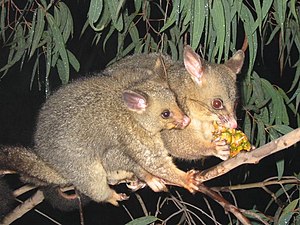
1080, the brand name given to the synthetic form of sodium fluoroacetate,[1] is used in New Zealand in efforts to control populations of possums, rats, stoat and rabbits,[2] which are invasive species in the New Zealand environment.[3] Although the Parliamentary Commissioner for the Environment deemed the use of 1080 in New Zealand "effective and safe" in a 2011 re-evaluation[4] and the substance is widely considered[5][6] to be the most effective tool currently available for controlling possums over large areas,[7][8] it remains a contentious issue, with the majority of the debate occurring between conservationists and livestock farmers on one side and hunters and animal-rights activists on the other.[9]
New Zealand is the largest user of 1080 poison,[10] using about 80% of the world's supply.[11] Biodegradable 1080 poison is the only poison currently registered for use on mainland New Zealand as suitable for aerial targeting of the common brushtail possum;[12] a major conservation and agricultural pest.[13] New Zealand has used 1080 for pest control since the late 1950s;[14] it imports sodium fluoroacetate in raw form from the United States of America.[15]
- ^ Proudfoot, A. T.; Bradberry, S. M.; Vale, J. A. (2006). "Sodium fluoroacetate poisoning". Toxicological Reviews. 25 (4): 213–219. doi:10.2165/00139709-200625040-00002. PMID 17288493. S2CID 29189551.
- ^ Green, W. (July 2004). "The use of 1080 for pest control" (PDF). The Animal Health Board and The Department of Conservation. Retrieved 16 December 2008.
- ^ Kolbert, Elizabeth (23 December 2014). "The Big Kill: New Zealand's crusade to rid itself of mammals". The New Yorker. Retrieved 23 December 2014.
- ^ Evaluating the use of 1080: Predators, poisons and silent forests (Parliamentary Commissioner for the Environment, June 2011): http://www.pce.parliament.nz/assets/Uploads/PCE-1080.pdf Archived 9 October 2011 at the Wayback Machine
- ^ "Frequently Asked Questions about 1080 | Forest and Bird". www.forestandbird.org.nz. Retrieved 19 June 2021.
- ^ "Alternatives to 1080". 1080: The facts. Retrieved 19 June 2021.
- ^ 1080 an effective tool to protect native wildlife (Office of the Minister of Conservation, 2008): http://www.doc.govt.nz/about-doc/news/media-releases/2008/1080-an-effective-tool-to-protect-native-wildlife/ Archived 7 November 2011 at the Wayback Machine
- ^ Call for reason in 1080 debate (Federated Farmers, 14 August 2008): http://www.fedfarm.org.nz/n628,10.html Archived 28 September 2011 at the Wayback Machine
- ^ Examples include:
- "Poison bait dropped in Fiordland National Park despite opposition". One News. Television New Zealand. 4 October 2010. Retrieved 19 May 2011.
- "Consent granted for 1080 drop". The Timaru Herald. 29 March 2011. Retrieved 19 May 2011.
- Williams, David (19 May 2011). "Alarm as 'hunters end' DOC's poison drop". The Press.
- ^ Cite error: The named reference
Beasleywas invoked but never defined (see the help page). - ^ 1080 Reassessment Application (Environmental Risk Management Authority, 2006): http://www.epa.govt.nz/search-databases/HSNO%20Application%20Register%20Documents/HRE05002-030.pdf Archived 25 March 2012 at the Wayback Machine
- ^ Technical Review of Sodium Monofluoroacetate (1080) Toxicology (Animal Health Board and Landcare Research New Zealand Limited 2002): AHB 1080 review - "In New Zealand 1080 is the most widely used poison (in carrot, cereal, paste and gel baits) for situations where possum numbers need to be reduced rapidly over large areas. It has been used in New Zealand for pest control since the 1950s and is the only poison that is registered for aerial control of possums."
- ^
Clout, M. N. (23 May 2011). "Ecological and economic costs of alien vertebrates in New Zealand". In Pimentel, David (ed.). Biological Invasions: Economic and Environmental Costs of Alien Plant, Animal, and Microbe Species (2 ed.). Boca Raton, Florida: CRC Press (published 2011). p. 286. ISBN 9781439829912.
The New Zealand [Department of Conservation (DOC)] administers nearly one-third of the land area of New Zealand and spends a large proportion of its budget on pest and weed control to protect biodiversity values. In 2008-2009, DOC spent NZ$29.9 million on animal pest control and NZ$20.3 million on weed control. The majority of the animal pest budget was spent on controlling alien mammals, dominated by possum control (NZ$14.9 million) and goat control (NZ$6.5 million). [...] Much of the regional government and agricultural sector expenditure on pest control [...] is also directed against possums and other vertebrate pests.
- ^ 1080: Killing pests and saving forests (Forest & Bird factsheet, 2002) : http://www.forestandbird.org.nz/files/file/factsheet_1080.pdf
- ^ Guidelines for the Safe Use of Sodium Fluoroacetate (Occupational Safety & Health Service, 2002 – ISBN 978-0-477-03664-1): http://www.pce.parliament.nz/assets/Uploads/PCE-1080.pdf Archived 9 October 2011 at the Wayback Machine